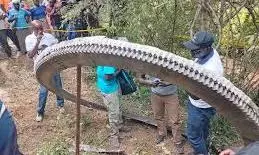
500 Kg space rocket debris crashes in Kenyan village, raises concern
text_fieldsA massive metallic fragment, believed to be part of a rocket, weighing approximately 500 kg, crashed into Mukuku village in Makueni County, Kenya, on December 30.
The Kenya Space Agency (KSA), in collaboration with local authorities, has secured the area and retrieved the debris for analysis. Fortunately, no casualties have been reported.
According to the KSA, the object is a metallic ring, around eight feet in diameter, identified as a separation ring from a launch vehicle. These rings are essential components of multi-stage rockets, detaching after fulfilling their role during a rocket’s ascent.
"The object poses no immediate threat to public safety," assured the KSA. Experts are analysing the debris to identify its origin and will update the public on the findings and next steps.
Although this is the first recorded instance of space debris falling in Kenya, such incidents are becoming increasingly common worldwide. Last year, a NASA rocket fragment pierced a home in Florida, leading to a lawsuit. Similarly, a satellite the size of a rhinoceros re-entered Earth's atmosphere over the North Pacific Ocean between Alaska and Hawaii in February 2023, as per the European Space Agency.
The incident in Kenya has reignited discussions about the looming threat of Kessler Syndrome - a scenario predicted by NASA scientist Donald J. Kessler in 1978. This hypothetical chain reaction of collisions in low Earth orbit (LEO) could render the orbit unusable, effectively halting advancements in space exploration and satellite deployment.
Dr. Vishnu Reddy, a planetary sciences professor at the University of Arizona, highlighted the rapid increase in space debris, stating, "The number of objects in space launched in the last four years has grown exponentially. We are nearing the scenario we’ve long feared."
LEO, spanning 100-1,200 miles above Earth, is now considered the planet’s largest garbage dump, with NASA estimating nearly 6,000 tons of debris orbiting Earth. This accumulation is expected to rise as private players continue launching satellites at an unprecedented rate.























